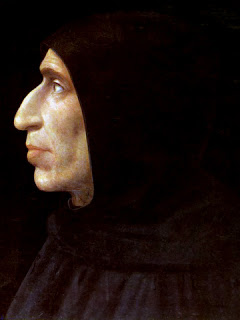The Dominican friar Girolamo Savonarola, originally from Ferrara, was hanged and burnt in the Piazza della Signoria in Florence on the 23rd May 1494. Every year, on the morning of the anniversary of his death, there is a renaissance parade from the Palazzo della Parte Guelfa to the Piazza della Signoria, where a wreath is laid over the plaque which marks the spot where the burning took place. Savonarola died, along with two of his most ardent followers, in the same square where he had held the infamous ‘Bonfire of the Vanities’ during the period of Lent in 1497 and 1498. Non-Christian books and art (drawings and paintings), and objects of earthly passion and distraction, such as cards, precious fabrics, make-up and wigs, were burnt in the square on a platform made of seven steps, symbolising the seven vices. Savonarola was an extremely influential preacher who called for great reforms of the church which provoked anger from the pope at the time, Alexander VI.
In 1491 he was made prior of San Marco monastery in Florence and began to preach in the cathedral. With the expulsion of the Medici family from Florence in 1494, due to a sharp decline in popularity after the death of Lorenzo the Magnificent de Medici and the incompetence of Piero de Medici, his son, to gain support from the people, Savonarola filled the power void and substituted humanist thought and neo-platonic philosophy with a theocratic government and an austere religious atmosphere for four years. Savonarola reorganised the government and, inspired by the Venetian model, increased political representation to 1500 people. He then commissioned an extension to the town hall, the ‘Salone del ‘500’ (Room of the 500), where the newly enlarged government could meet, in three sittings of 500 people at a time, giving name to the room. He referred to it as the Hall of Christ.
His sermons increased in religious fervour and he claimed that Christ was speaking through him, he being a prophet of Christ. He attacked the papacy, who initially offered him a cardinal’s hat to silence him, which he rejected, before excommunicating him. Cesare Borgia, the head of the papal army and the pope’s son, came to Florence where a forced confession was taken from the friar, followed by his death in the square.
Due to the austerity and fanatical nature of his reign, opposition had grown in Florence. The opponents of Savonarola, dubbed the Arrabbiati (Angry Ones), called the Dominican’s closest followers the Piagnoni (Wailers) as they complained incessantly and spoke endlessly of the end of the world. After Savonarola was burned, his ashes were gathered and sprinkled over the Arno to avoid them being collected and kept by his believers, although the cult of Savonarola continued throughout the sixteenth century.
Savonarola’s cell in San Marco, Florence Visitors to the beautiful San Marco monastery can enter his cell where many of the sermons would have been written and can see the bell that called the Florentines to hear him speak. This bell was exiled to outside the walls, to the dreaded enemy of the Dominicans, the Franciscan church San Salvatore al Monte, after his death. A few years later the Gonfaloniere Pier Soderini, head of the Republic, in an act of clemency, returned the bell to the Dominicans.
The hanging & burning of Savonarola in Piazza della Signoria – an anonymous painting from 1498 in the Museo di San Marco






